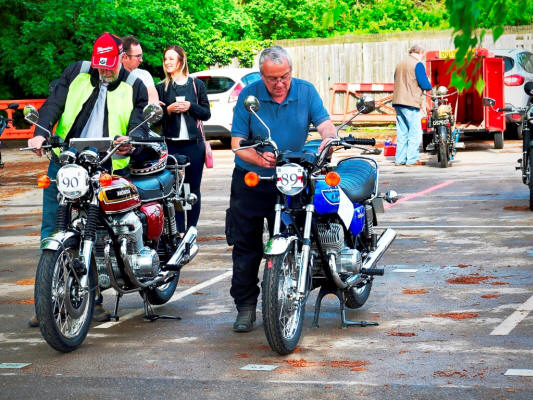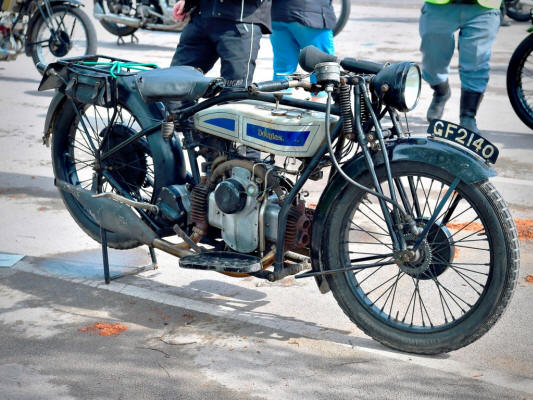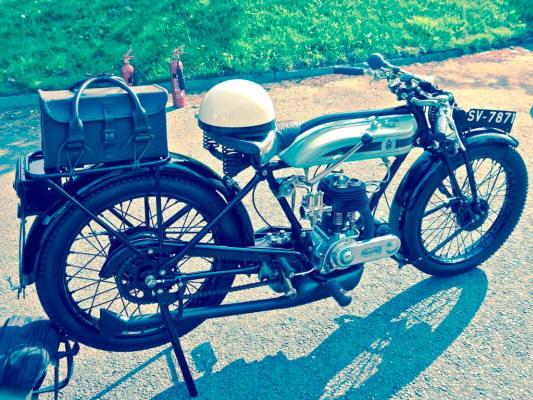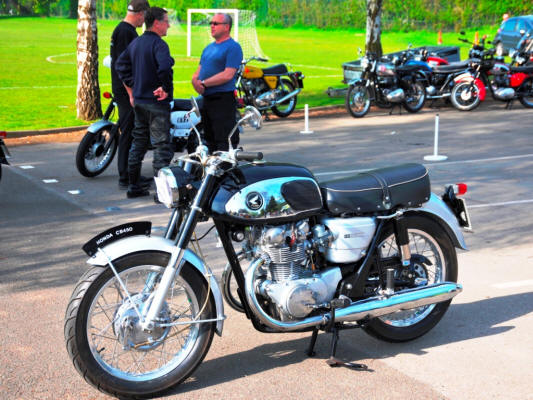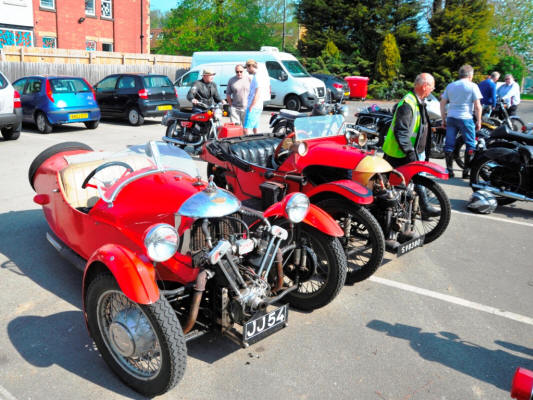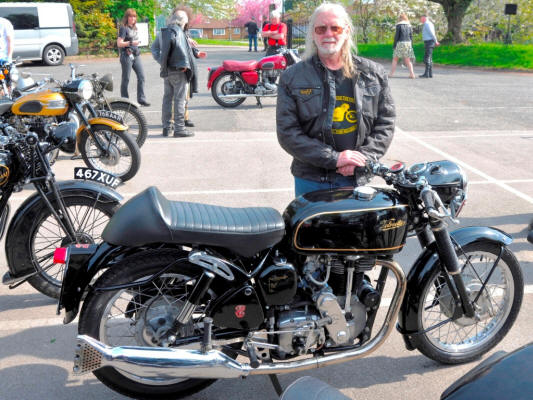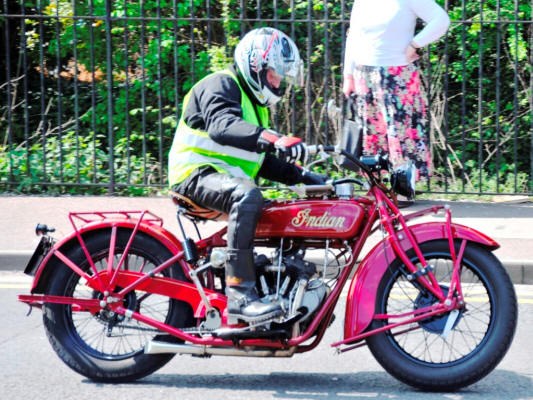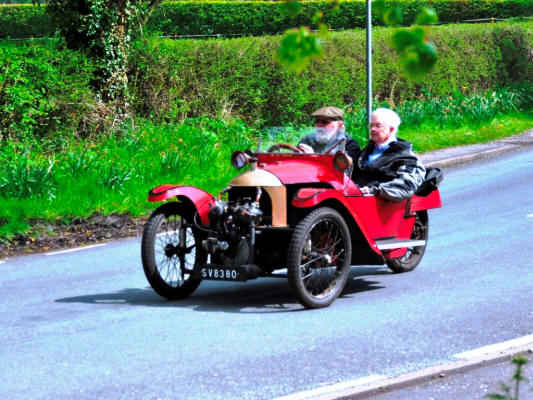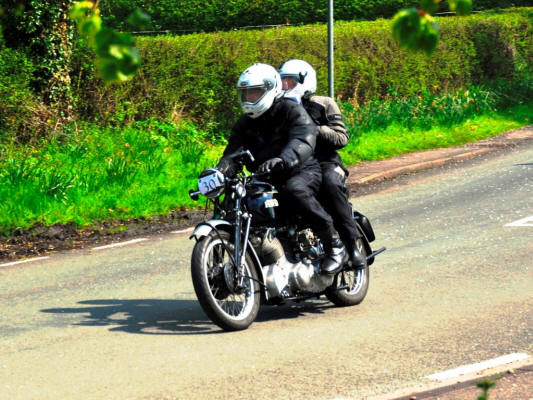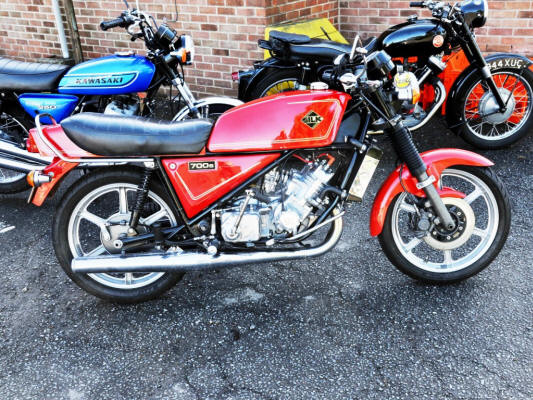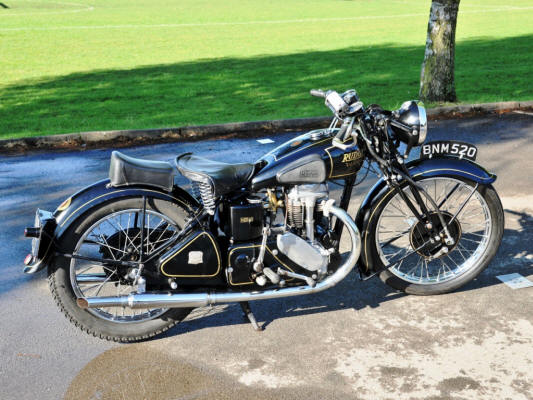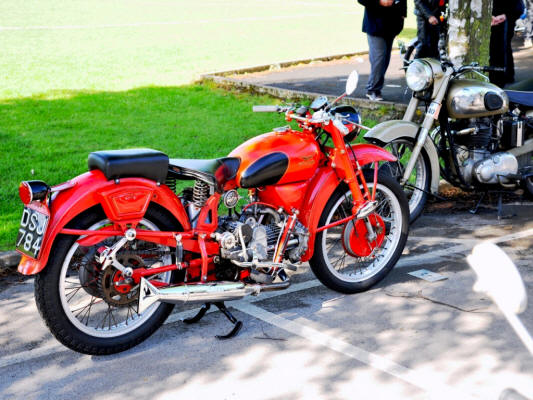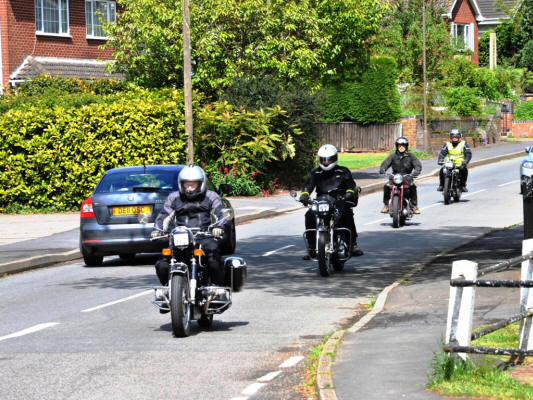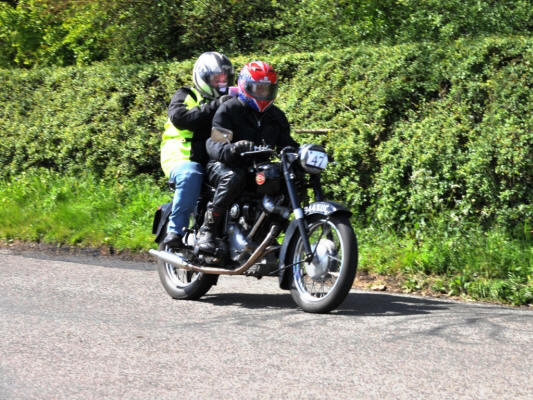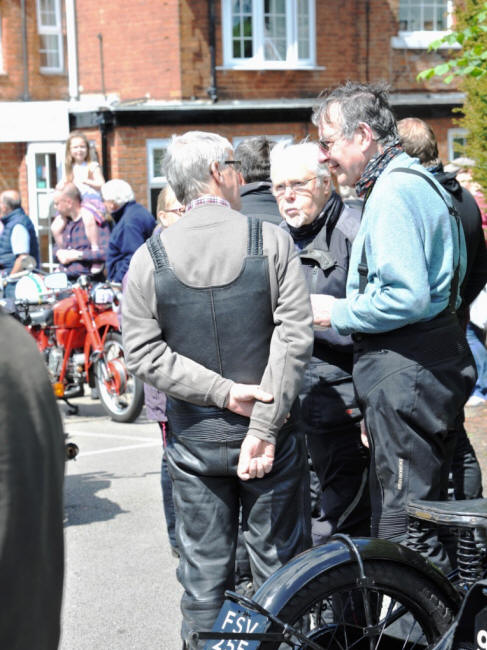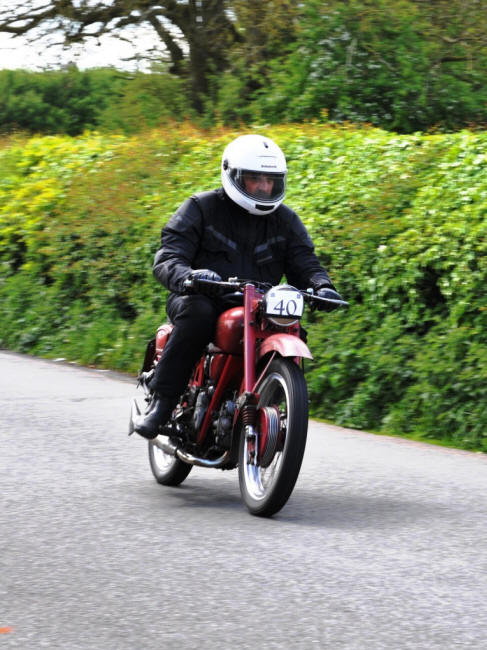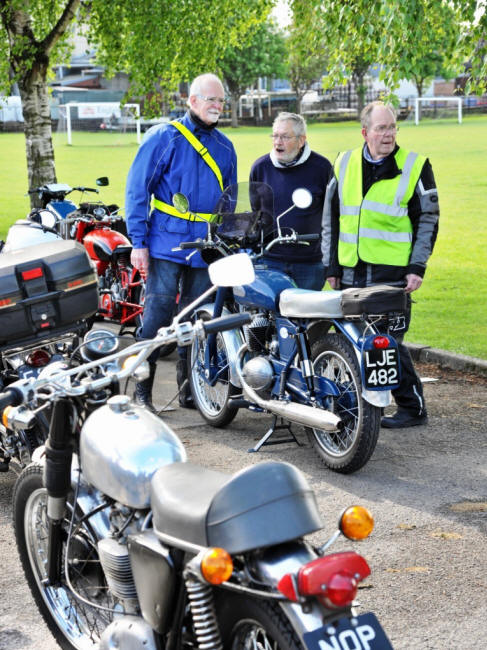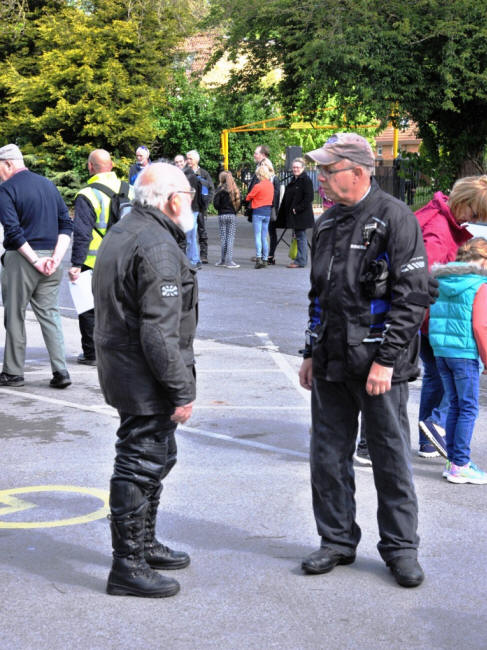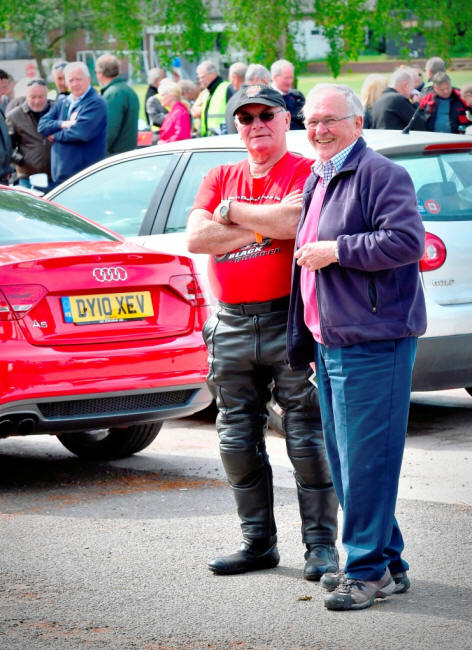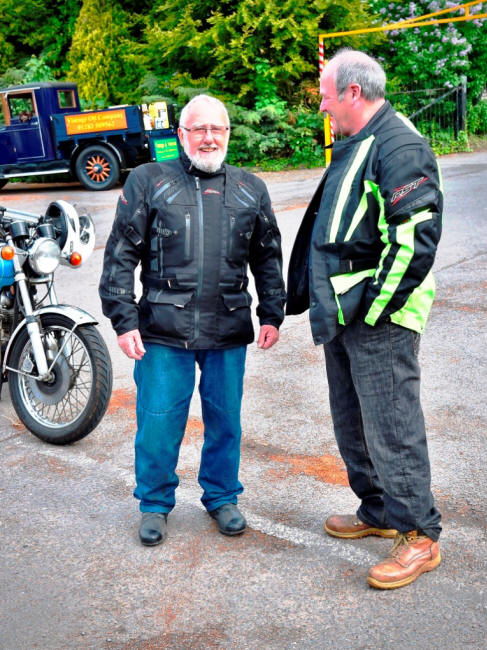Chat 19
Here is an easier picture quiz from Pat Robotham. No clues, even I know what it is! Answers by email to: edgrew@virginmedia.com
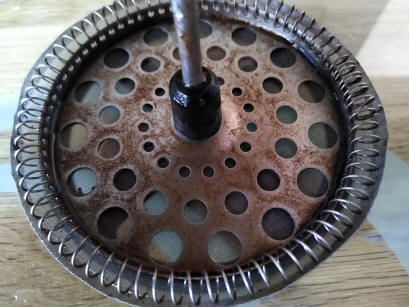
Picture quiz question for Chat 18 was:- What is the link to these two pictures? The answer was Tesla. Nikola Tesla was an engineer and scientist known for designing the alternating-current (AC) electric system, which is the predominant electrical system used across the world today. He also created the "Tesla coil," which is still used in radio technology. He worked with Thomas Edison for a time. You can read a short biography here.
Correct answers from:- Don Eades, Mick, Dughan
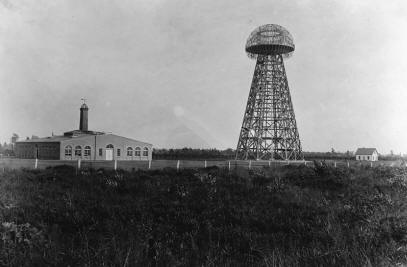
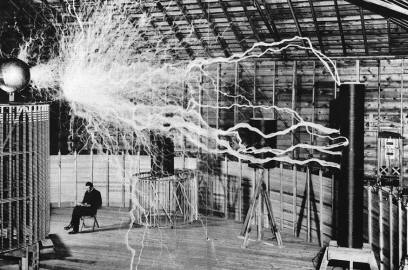
I think this quiz was quite difficult,
especially as the clues were somewhat cryptic. The question
was:- "What is this piston from?"
The
clues were:- It is not from a bike engine, it is from a car.
The next clue was:- Blue oval/water crossing
the road put some money into early development but that is not the
answer.
The answer is The piston is from the V8 Cosworth DFV (Double Four Valve) engine. In the late 60's Ford were initially involved, putting in the money for Keith Duckworth to design the engine that was produced by Cosworth. 1970s, it was used by nearly all F1 teams.
Correct answer from:- Don Eades,
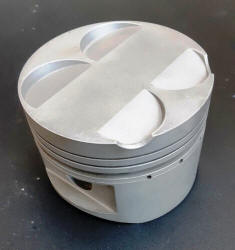
Pat Robotham's first motorised transport and his Motorcycling
Memories.
I was born in 1951 in Sway in the New Forest
in Hampshire, and lived there until I was 18 leaving home for
university. I was sent away to school in the depths of rural
Somerset, this was because my father worked as a commercial pilot
for BOAC and frequently had to live and work abroad and he took my
mother with him.
The New Forest, is an area of natural heath
land, and forest/woodland plantations on poor gravel based soils
basically in a rough square between Bournemouth and Southampton on
the coast up to Salisbury plain. And covers an area of about 350
square miles. It dates back to 1066 when William the Conqueror
decided he wanted a “new” place to hunt deer, so he designated it a
New Forest, with all the strange local laws and rules that still
persist today
I believe we ended up there in the first place
because all the pilots of what was the new airline BOAC, once they
had returned from the war, were told that the new national airport
would be at Herne , an old military airfield. However, once they had
all moved there the plans changed and they developed Heathrow but
all the pilots stayed in the Forest.
At that time, it was a number of fairly distant
isolated villages, and communities mostly of “locals” with a
smattering of “incomers” like us trying to fit in.
There were also a few small towns and the bigger towns
mentioned previously although they are not strictly in the forest.
I was once asked were I came
from and as I could not be bothered to explain said simply,
Bournemouth, to which came the reply, “ people don’t come from
Bournemouth they just go there to die.”
It had always had a
retirement atmosphere even then.
The whole area was serviced by an adequate set
of railway branch lines until the arrival of Beeching who shut the
lot and isolated the communities’ even further at a single stroke.
The bus service was wholly
inadequate if you lived out in the sticks as I did from about 1963,
in a place miles from anywhere called Bisterne Close, near the
village of Burley two miles up a seriously challenging dirt and
gravel track.
Up until the age of sixteen I had kept in touch
with my limited social life by bicycle. The main problem with this
was that to see anyone required at least a twenty mile round trip
frequently longer, and one feature of the Forest is because it is
quite close to the sea it is subject to high winds particularly on
the most open roads, which was most of the ones I cycled.
When I got to sixteen, and because I was
staying on at school to do A levels, the expectation was that I
would get a job over the summer holidays.
Fine by me as it would give
me some financial independence, so long as I could find something.
I got a job three miles from
home in a country house hotel called The Burley Manor, as a waiter.
I don’t remember the wages
but it was long hours for not much money, but I did learn how to do
silver service, a skill I have never used since.
I think I did this job for
about seven weeks and because there was nothing to spend the money
on and no time to spend it, it built up to about £30.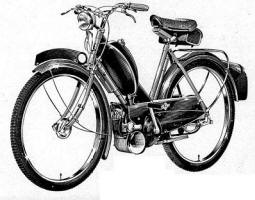
I developed a plan; I would buy a motorcycle
and solve all my transport/social needs.
The only trouble was my
mother who was obsessively anti risk of any kind and that included
motorcycles. I could
have ignored her protests and bought one anyway, after all it was my
hard earned money, but I knew I would never live it down and the
issue would be raised again and again.
I simply could not be
bothered to put up with that. One day I was in the town of New
Milton, looking in the local bike shop window.
There was a reasonably new
Raleigh M3 Runabout moped. OK
it was not my dream machine, it looked pretty naff just like what it
was really, a heavyweight bike with a little two stroke engine
attached. It was hardly
“The Leather Boys”, but I reckoned |I could persuade my mum it would
be just the thing both of us needed safe and convenient.
This I managed to do, and my
lonely life changed forever.
The New Forest has a number of its own
highway hazards. The best
known to most is the ponies. According to William 1st
laws, in the Forest ponies have right of way, hit one and you are in
trouble in more ways than one. They
also like to congregate under the road bridges in the summer to get
in the shade and away from flies. Finally,
the trippers who come to The Forest often like to feed them, which
is illegal because it encourages them onto the roads.
The second hazard is little patches of fog
which accumulate particularly in the many road depressions as they
pass through the wet boggy heath either side.
These are most frequent at
night or early morning and frequently have, you guessed it, ponies
in the middle of the fog.
Finally, what are known locally as “Water
splashes”, everyone else calls the fords but in the Forest they are
water splashes. There are
hundreds of them. They
are usually quite slippery, and often with, you guessed it again,
ponies drinking in them, which is probably why they are slippery.
The Runabout served me adequately for about
eighteen months until I took my car test.
My mother was so keen to get me off two wheels she then lent
me her car. This suffered a freak accident while I was driving to
see a mate when a decent sized female deer jumped over a hedge and
landed on the bonnet. It was quite a shock, but one of those
“forest” things.
I do remember mates from home having Puch
Maxis, Royal Enfield Crusader sports and an Ariel Huntmaster, all of
which |I rode occasionally, and a James ML which we found in an old
outbuilding, with the hand change through the tank.
Away at school there was also a secret shed we
borrowed and filled with decrepit old motorcycles, Cubs, C15s, even
a Triumph twin. We would
occasionally be able to get them going, funds and expertise
allowing, and get the odd ride. On
Friday afternoons my school insisted that we all play soldiers,
which seems utterly pointless to me until they started the MT
section which I was allowed to join.
There I learnt the ways of Army mechanical fault finding
through a test we had to sit at an army camp near Yeovil.
The test was called
certificate T and it taught me one essential lesson.
In all fault finding only
change one thing at a time”, a lesson I have usually followed, and
which has stood me in good stead. In
the summer of 1968, I did ride down from Salisbury to St Maws in
Cornwall, about 150miles on the back of my mate Newts LI150
Lambretta scooter. A
very cheap trip, we were going on our first holiday ever away from
parents. Staying in a free
flat and eating boiled limpets off the beach to save money for beer.
We rode each other’s bikes, a C15 and a Suzuki super six and the
Lambretta. I told my mum I was going in Newts car a 600cc Fiat but
when I got to his place it would not start.
Then came University and marriage in 1971 and
my dad gave us his old Triumph Herald estate car as a wedding
present. I learnt a bit more
engine maintenance, and what it cost to run a car when not having
any money. My father - in -
law was an ace amateur mechanic and taught me a lot.
1972 saw me working as a
research student and we were living in the middle of London near
Camden Town. So, to be honest
we didn’t need a car which we could not afford.
Then came the OPEC oil crisis
and petrol went up to 50p per gallon and was informally rationed at
filling stations to one or two gallons per vehicle.
I suggested to Shelley that we get rid of the
car and buy a motorbike and she agreed, so off we went to Pride and
Clarkes in Stockwell road. As I did not have my test, it was a
choice between a Suzuki Bloop or a 250 BSA Starfire. I figured that
to carry a pillion I needed at least a 250, in addition to taking
and passing a test, so I went for the BSA.
I got £75 for the car because
“nobody wants a car at the moment due to the cost of petrol,” and
paid £125 for the BSA because “everyone wants a motorbike because of
the cost of petrol.” I rode
it back from Stockwell road right through the rush hour up
Southampton Row, learning to ride a proper bike with gears, etc all
the way home. Arh the
stupidity of youth.
So started my continued ownership, riding,
maintenance, and rebuilding of motorcycles, from the gutter to the
workshop, from the ordinary to quite exotic.
The BSA was not a good bike, it was an over
tweaked C15 which had had a series of unforgiving owners over its
5-year life. The handling,
frame, brakes and forks were quite superb, the engine and especially
the kick start mechanism, which appeared to be made form cheese,
were not good. Still, I learnt a lot of mechanical things from a
group of “helpful” passers-by as I squatted in the gutter by the
main road outside our flat, with the bloody thing in bits.
To be fair I did meet some
really helpful folk, many of whom lived in the empty terraced houses
down the road as squatters.
They had access to workshops they had converted and in which
I could occasionally work on my bikes.
I suppose if you had shoulder
length hair, a beard, a pair of what were known as “loon pants” and
then a motorbike, you fitted in pretty well to what was a Hippy
existence. I remember going
to the workshop down the road to work on the bike to find it closed
because they were filming a pornographic film in among the bikes.
Don’t know how the performers didn’t get all oily, as I never saw
the end result.
We used to regularly ride down to see our
parents who were about 100 miles away and mostly we got back with a
bit of roadside fiddling.
Then I passed my test and the BSA had to go.
I sold it with a broken kick
start as the spares simply were not available from any of the North
London bike dealers and I inhabited them all.
Exchange and Mart was scrutinised and a trip to
“The Right On Trucking Company” ( remember the Robert Crumb cartoon
character in the “Keep On Trucking” cartoon and the cartoons on the
cover of the first Janis Joplin album, “Cheap Thrills”.
That was what inspired this
bike dealership. You entered
to the smell of petrol, oil, and dope but there was my dream, a 1962
650cc Triumph Bikini backed 6T.
It had had a bad engine rebuild judging by the
amount of gasket goo on the outside and it had a lot of its tin ware
missing. But it ran and had
an M-o-T. and I loved it.
I bought it for £150 and rode it home to Tufnell Park.
For some reason I decided I liked the original
semi clad look of the bike even though much of it was missing.
I could have ripped it all
off and replaced with more modern looking parts, which was commonly
done in 1973. I used to meet
cartoonist Paul Sample of Ogri fame in the cue for parts at
Humphries in Islington.
He had completely re styled an “S” Sunbeam with his own elaborate
tank paint job, all rather “Easy Rider”.
So, to decide to put the 6T
back to original aesthetic spec was probably an odd choice.
However, in London at the
time were dozens of parts suppliers selling off basically old stock
from Triumph and BSA, Hamrax motors came up with most of the missing
tin ware and the rest as they say is history.
The bike got used for
commuting, travel around London, and trips back home to the south
coast and the New forest. I
never added up the miles but in four years of ownership must have
been 30 or 40 thousand. Not trouble free by any means but always
fixable.
In order to make a few extra pounds I bought a
range of derelicts from my squatter pals and sorted them out, M-o-T,
rode them for a bit and sold them. I
remember a full bathtub distributor 3TA which had appalling brakes
and dreadful soft suspension and a rather nice A10 which was a fine,
smooth, machine to ride, but I needed the money, so it had to go.
I found a Yamaha 90 step through in a big bin
at a lab I was working in and asked around.
I was pointed to the owner
who said I could have it for a fiver, which seemed bit rich as it
was in the bin but I was looking for a bike for Shelley, so bought
it and got it Transported home to the curb side workshop. It was
really good apart from a stripped kickstart which was fixed by a
blob of weld from a mate. Shelley passed her test on it and used it
a lot.
In 1976 I had finished my research project, got
my higher degree and managed to get a job eventually with the new
Severn Trent Water Authority as a contract fisheries researcher.
I was based in Malvern and working across Shropshire into mid
and North Wales, so we needed to move.
We bought a BMC J4 van off a
couple of Australians who were going back to Oz.
We loaded up the tools, the Triumph and a recently acquired
Enfield Bullet and I headed north to Malvern with the intention of
camping out in it until Shelley arrived nearer Christmas having
worked out her notice. Fortunately,
one of my new work colleagues took pity on me and I slept in his
spare room for a couple of months. The
bikes stayed largely in the van.
An amusing little story involving my Sunbeam, myself and my brother
John who raced it. There is one other person in this story and that
is Gary Gardiner. Gary was a pleasant and very enthusiastic young
man who had taken on the role of commentator at our vintage race
meetings. I often used to visit Gary in the commentary box for a
quick word with Gary and his father, another very nice man. They
made a really good team with Gary doing the talking and dad making
notes and passing on bits of information.
One year at our early Mallory Park vintage race meeting Gary was
combing the race paddock talking to racers and their teams for
snippets of information that he could use during his race
commentary. I told you he was enthusiastic, he was keen to make a
good job as a commentator.
Racing is a serious business, but we always look on the brighter
side of life and look for an opportunity for a bit of fun. Gary’s
knowledge of the internal combustion engine was minimal so when he
asked us if we had made any mods to the Sunbeam over the winter. It
was an opportunity too good to miss. John launched into a story
listing some of the smaller changes we had made before telling Gary
that the most important mod was to fit a rubber connecting rod that
greatly improved engine performance. He then carried on to tell him
that the when the engine was running the rubber con-rod stretched
and raised the compression ratio. The faster the engine went the
more the con-rod stretched. The more it stretched, the higher the
compression ratio became and even more power was produced.
Gary went on his way smiling, armed with this little gem of John’s
imagination filed away. We were both laughing and smiling too at
how easy it was to get Gary to swallow John’s fiction, hook, line
and sinker.
It gets even better. We didn’t know that Gary had
recorded the conversation. At the lunch break, when the race paddock
was relatively quiet Gary played the recording back to the whole
paddock over the Tannoy. There was then lots more laughing and smiling
faces. Eddy
They made the four cylinder Cirrus engine in two scales 1/12 and 1/6
which came out as a 2cc 4 cylinder OHV engine and an 18cc version
with Radio control throttle a very useable engine and they sounded
beautiful too. These were later produced as a variant of the Vee
four at 4cc and included a water cooled version all the others being
air cooled. I discovered they made a water cooled four cylinder
double overhead camshaft four cylinder 50cc engine and so I had this
idea to build one into a 50cc racer project?? I show this little
masterpiece in the three pictures. It was a beauty. It had a toothed
belt drive to the oil pump for lubrication and a similarly driven
water pump for cooling. It was normally used in model boats!
I’m
Pickin’ Up Good Vibrations – Part 2
So the 1980’s found me raising a family and
working hard for the money to feed the mortgage. I was lucky in
having retained two motorcycles during this period; my BMW 750 R75/6
and a ‘Desert Racer’ 600 Matchless single that I had rebuilt prior
to marriage. I felt lucky that I hadn’t experienced the “gap years”
as so many of my peers had owing to commitments.
As previously mentioned, I had owned virtually every AJS / Matchless post war model, but two bikes had evaded me. One was the all alloy competition single and the other the ‘parts bin special’ known as the ‘Desert Sled’ powered by the 750 Norton Atlas engine. I found a competition single for sale in the Matchy Owners Club magazine, but never found a 750 twin for sale at that time.
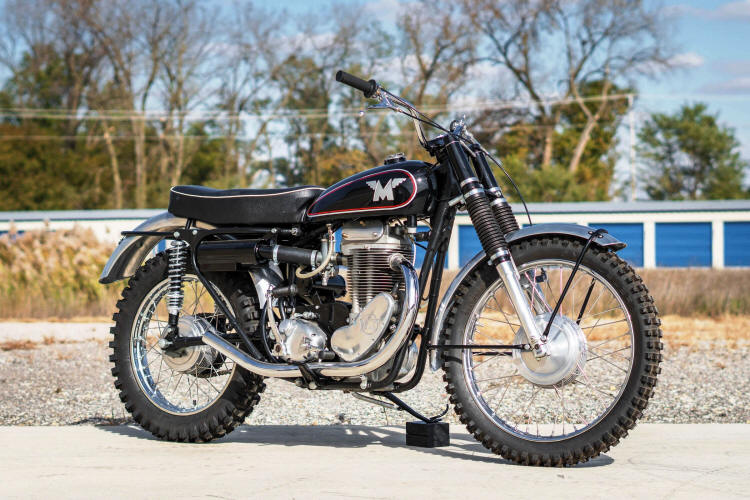
Typical 600 cc Matchless ‘Desert
Racer’ Typhoon
A telephone call to the vendor confirmed that
the competition bike was still for sale and it was actually a rare
600 single called the ‘Typhoon’. These were built for the American
desert racers who wanted “more cubes”, a familiar tune! The price
seemed reasonable and I had a little bit of “pocket money”. This was
a time before the inflated prices started.
The chap on the end of the phone sounded “posh”
as he gave directions to his property. Next day a friend gave me a
lift on the back of his bike to the ‘stockbroker belt’ on the
outskirts of London. It was a typical cold and foggy winter’s ride
and we were quite cold as we rode into one of the double entrance
drives that led to this palatial building. The bike was standing in
front of a large garage and I eagerly knocked on the front door with
one eye cocked towards the single. A middle aged man opened the door
and I asked if we could have a good look at the bike and start it
up, especially as if I did purchase it, the intension was to ride it
back home to Derbyshire. He said abruptly that we could inspect the
bike and to knock again with the money if the sale was on, at which
point the door slammed shut!
The bike started up easily and sounded quite
healthy. A second knock on the front door summoned the owner and
cash was exchanged for the logbook. The door promptly slammed shut
again. It would have been nice to be offered a cup of tea, but he
probably wanted to check his financial standing. There’s nowt so
queer as folk!
I completely renovated the Matchless and even
managed to obtain an original 7R front wheel to improve the pretty
marginal front brake. There wasn’t much remanufacturing going on
back then and I wanted some parts for this rare model. The only
place that seemed to have any bits was Russell motors in Battersea,
When I dismantled the Typhoon, it became
obvious that it was a bitza. There were no matching numbers, so I
saved up some more cash and set off for London to see if Russells
had any parts. I eventually found their poky little shop and had
already spotted some “treasure” in the front window. I bought new
crankcases, barrel, head etc. etc. I couldn’t believe this bonanza.
I enquired how they had all these tasty parts. The story goes that
when the Plumstead factory finally closed Russells had a phone call
suggesting they turn up quickly to get some stuff or it would all
disappear. They were only round the corner from the factory so it
was “in the right place at the right time”.
All this excitement had made me hungry and
thirsty, so I asked if there was a pub nearby. Directions were given
and I soon found myself in a typical
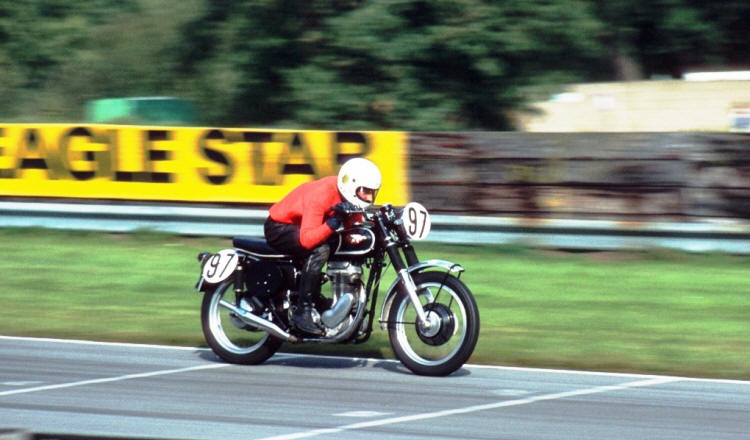
At speed – classic racing at Oulton Park
I have never gone to work in a car and the BMW
was doing sterling work, day after day. The bike soon clocked up
100,000 miles and was very reliable. My restored 600 single was a
lovely looking bike, in my humble opinion, and had plenty of poke,
but that irritation of excess vibration niggled away, especially
when I jumped straight off the smooth BM onto the Matchless. That
huge single piston flying up and down had its consequences.
It’s all to do with horsepower
I was reading an article about the Paris-Dakar
Rally in one of the bike magazines and the gist of the story was how
Yamaha, who had won the earliest rallies were now eclipsed by not
only BMW, but also an unlikely winner in the shape of a Ducati 90
degree V-twin engined Cagiva. Yamaha had their 750 Super Tenere
vertical twin, but reports suggested that the Cagiva 90 degree
twin’s out of step firing order gave more traction through the sand
with the rear tyre’s “stuttered” bite.
The engineers at Yamaha might have read Phil
Irving’s article about “out of step crankshaft” vertical twins; not
only reducing vibration but also with the bonus of better traction
through sand. Next year saw the work’s Paris-Dakar bike enlarged to
850 with a 90 degree out of step crankshaft. Guess who won for
several years? Yamaha rediscovered this attribute in recent times
with the M1 four-cylinder Moto GP winning bikes when they fitted an
“out of phase” crossplane crank that improved rear wheel traction
Yamaha sold a road going replica of their 750
Super Tenere and also used the engine cases to make an 850 road
going all rounder called the TDM. Both these models used a typical
360 degree crank layout early on, but the new 850 TDM would now be
fitted with the Paris-Dakar-esque out of step crank. This mimics a
90 degree v-twin in sound and feel with the added benefit of the
lowered vibration. That Phil Irving article never left my thoughts
and some how I had to raise the cash to buy one.
I seemed to have gravitated to twins and
singles, apart from a brief encounter with that new Triumph Trident
and the odd ride on Japanese fours, so the thought of another
compact vertical twin with low vibration was very appealing. Another
influence was my love of the sound and feel of a v-twin; that “dee-dum,
dee-dum” offbeat sound that mimics a heart beating; that visceral
feeling. The TDM would fit the bill nicely. All I had to do was fund
the purchase. This proved to be an emotional experience.
The BMW had now clocked well over 120,000 hard
miles and needed a rebuild. It might raise a bit of cash and I would
be sad to sell my faithful steed, but BMW spares are expensive so
that was a lever to let her go. How could I ever contemplate selling
the competition single? However, being a rare bike increased its
intrinsic value and I did the unthinkable of selling my last
connection with AMC. I never thought AMC bikes were better than any
other makes. Remember my first “big” bike was that cheap 350
Matchless and the rest followed as if by accident.
The BMW had been a faithful steed.
So, I took delivery of a new 850 “wobbly crank”
TDM Yamaha in silver and yellow. To me it was like a modern Norton
Commando, smooth and with loads of low down torque. I was “Pickin’
up good vibrations”. It had an advantage over my Commando in having
an electric start. That Norton twin engine took some kicking over,
especially with high compression pistons. An example of this was
when I went to part exchange the Norton for the Ducati V-twin. Many
of Norton engines destroyed the main bearings very quickly. An
engine designed just post war was now expected to produce three
times more BHP and with the Commando rider isolated from any engine
vibration, prolonged high revs were common. This was a recipe for
disaster. The Ducati salesman insisted that he wanted to check for
rumbling main bearings and asked if he could start the bike. He was
most embarrassed when he couldn’t even turn the engine over and just
bounced on the kickstart! I’d cut my teeth on big singles so
starting it was second nature and it started first kick for me.
Norton eventually fixed the problem by fitting ‘super blend’
bearings. These special
main bearings have slightly “barrelled” rollers and allow the crank
to flex at high revs without the rollers “digging” into the outer
races.
So I settled into enjoying my time with the
Yamaha. The “out of phase” crank offered me the pseudo feel of a
V-twin that gave me “good vibrations”. Yamaha actually went one step
further with the TDM and fitted balancer shafts. Other riders
enquired what it was like to ride and replied that it was “like a
V-twin single”.
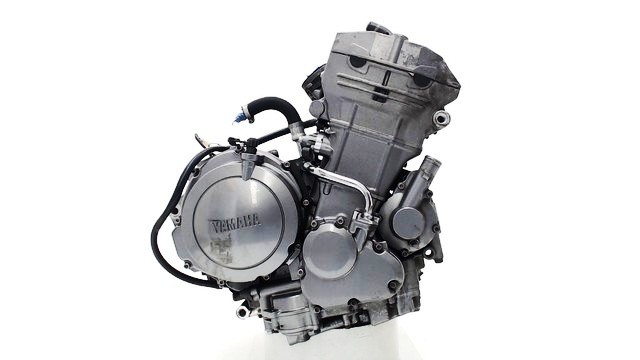
Compact dry sump TDM engine
I often wondered what would have transpired if
the British bike industry had taken up
The BSA and Triumph engines were cheap and
cheerful. They did a good job and could be made quick and reliable
in the right hands. Remember Chris Vincent won the 1962 Sidecar TT
using a BSA twin. However, unless you make a crank from scratch, as
Nourish Engineering still do, you are stuck with modifying the
standard crank and it is far more complicated. Then my attention
turned to the Norton Atlas/Commando crank. This is a bolted-up
structure with a heavy central cast iron flywheel and forged outer
crank “cheeks”. The whole lot is held together by high tensile
bolts. Tony Harris (of recent ‘Chat’ Ariel V-twin fame) was also
thinking along similar lines. We found that if we turned one crank
cheek 90 degrees to the other the bolt holes didn’t line up, but
more importantly they didn’t overlap by say half a hole that would
prove problematic. “All” that was needed was a new central flywheel
“spacer”. The jigsaw pieces started to fit together in my mind; an
So, this research sowed the seeds and I started
to look for bits to build a 750 G15 ‘Desert Sled’ Matchless special,
the missing link in my AMC model ownership.
To be continued .........
What a busy week, I’ve had. Last weekend I had the Relay Rally and now have to think the Burton Parade.
Mind you I did enjoy the Relay Rally, the roads were virtually traffic free and I’ve never known the B31 run so well, you could not believe that the engine was running, it was so quiet. Performance was also spectacular, I must have visited virtually every checkpoint and didn’t use a drop of fuel. On the downside I need to check the odometer since no mileage was recorded!
I've sorted this out for the Parade since distances between junctions are vital. Talking of the Parade the Committee done all the usual preparations, Brian has the routes sorted, Ann has sorted the entries, Vic has the venue and coffee stop booked, John Stone has all the trophies ready, Jackie and Denise are ready to empty your pockets for the raffle, in fact everything is sorted except as you know it is not going to happen, at least not just yet.
You can however celebrate the day, John Stone is starting the day with a cooked breakfast, real not virtual, I have some nice crusty bread and cheese and onion with a bottle of Pedigree to wash it down for the buffet when I get back from my virtual parade, I might even get a virtual trophy this year which would be nice, but I will enjoy the day as usual anyway.���� Mick
Photographs
